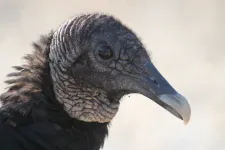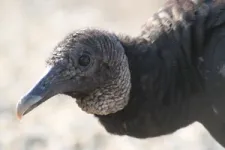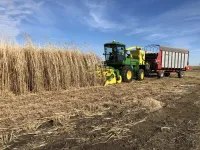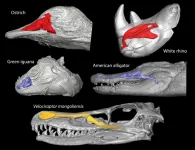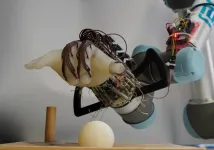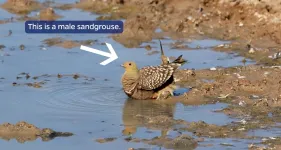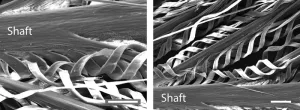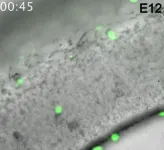(Press-News.org) Since the 1950s, humanity has produced an estimated 8.3bn tons of plastic, adding a further 380m tons to this amount each year. Only 9% of this gets recycled. The inevitable result is that plastic is everywhere, from the depths of the oceans to the summit of Everest – and notoriously, inside the tissues of humans and other organisms.
The long-term effects of ingested plastic on people aren’t yet known. But in rodents, ingested microplastics can impair the function of the liver, intestines, and exocrine and reproductive organs.
Especially at risk of ingesting plastic are scavenging birds. For example, New World vultures regularly forage at landfills, and have been observed to leisurely pick at synthetic materials such as boat seats, rubber seals, or roofs.
Now, researchers from the US have shown that the amount of plastic ingested by black and turkey vultures (Coragyps atratus and Cathartes aura) can be predicted from their location on suburban and exurban maps. This isn’t just a distinction between country versus city birds: the amount ingested depends on the local density of human commerce within urbanized landscapes. These findings are published in Frontiers in Ecology and Evolution.
“Here we show that black vultures and turkey vultures in areas with more urban development and a greater density of commercial food providers ingest more plastic,” said Hannah Partridge, a doctoral student at the Department of Geography and Earth Sciences of the University of North Carolina at Charlotte, and the study’s first author.
“It’s possible that they eat some of this plastic on purpose rather than exclusively by accident, as is typically believed.”
Vulture pellets record plastic consumption
In 2021 and 2022, Partridge et al. studied eight communal roosts shared by black and turkey vultures across the Charlotte Metropolitan Area (human population 2.8m and growing). Roosts typically host between 20 and 500 vultures. Beneath the roosts, they collected a total of 1,087 pellets of undigested material vomited up by the vultures.
Of these pellets, 60% were found to contain plastic, making up 2.7% of the total mass on average. Other components included vegetation, dirt, rocks, animal remains, metal, fabric, paper, wood, and glass. The authors could identify the types of plastic material with Fourier transform infrared (FTIR) spectroscopy: most commonly found were silicone rubber (7.5% of samples analyzed), high density polyethylene (7.0%), polyethylene (6.4%), and silicate bio polyethylene (5.3%).
The researchers then searched for associations between the amount of plastic within pellets and four measures of human development within increasing distance – from 400 meters to 20km as the vulture flies – from the roost. These were the density of commercial food providers (from mom-and-pop stores and food trucks to supermarkets and restaurants), the density of livestock and game producers, the amount of developed landcover, and the distance to the nearest landfill.
Food stores and restaurants
Exploratory statistical analyses showed that the proportion of pellet mass composed of plastic strongly increased with increasing urban landcover and increasing density of food providers within 20km. From these results and direct observations, the authors concluded that especially black vultures in the Charlotte Metropolitan Area may be primarily ingesting plastics directly at dumpsters belonging to food providers.
“Black vultures will often roost overnight on a transmission tower next to a fast food restaurant and fly straight to the dumpster first thing in the morning,” observed Partridge. “Turkey vultures do this less often: they prefer more rural areas and natural food sources.”
Curious birds
But do the vultures eat all this plastic on purpose or by accident? The researchers hypothesized that vultures may commonly mistake plastic for nutritious bone fragments, which they would normally get from carrion.
“Vultures are curious and always looking for new food sources, so they may ingest plastic thinking it’s food,” said Partridge. “But they may also sometimes ingest plastic intentionally, to collect bulk to help vomit up indigestible parts of carrion like hair.”
So what can we do to prevent plastic from being eaten by vultures and other vulnerable animals?
“Food providers such as restaurants and grocery stores can ensure that their garbage is properly bagged, that trash makes it to the dumpster, and that the dumpster is closed and secured. We can also work towards banning single-use plastics to protect vultures and other species from harm,” advised senior author Dr Sara Gagné, an associate professor in the same department.
END
Most plastic eaten by city vultures comes straight from food outlets
Vultures may ingest plastic on purpose to induce vomiting
2023-04-12
ELSE PRESS RELEASES FROM THIS DATE:
To more effectively sequester biomass and carbon, just add salt
2023-04-12
Reducing global greenhouse gas emissions is critical to avoiding a climate disaster, but current carbon removal methods are proving to be inadequate and costly. Now researchers from the University of California, Berkeley, have proposed a scalable solution that uses simple, inexpensive technologies to remove carbon from our atmosphere and safely store it for thousands of years.
As reported today in the journal Proceedings of the National Academy of Sciences, researchers propose growing biomass crops to capture carbon from the air, then burying the harvested vegetation in engineered dry biolandfills. This ...
How to cool your brain? These warm-blooded animals use their nose
2023-04-12
A research team led by Seishiro Tada and Takanobu Tsuihiji of the University of Tokyo shows that the living warm-blooded descendants of theropod dinosaurs evolved a better nasal cooling system aided by larger nasal cavities than cold-blooded animals. The study provides clues to the evolution of nasal cooling in warm-blooded animals from their theropod dinosaur ancestors.
Endotherms, or warm-blooded animals, maintain their high body temperature through internal heat sources. Birds, humans, and other mammals are endotherms. But ectotherms, or cold-blooded animals such as reptiles, use external heat sources to keep ...
It’s all in the wrist: energy-efficient robot hand learns how not to drop the ball
2023-04-12
Researchers have designed a low-cost, energy-efficient robotic hand that can grasp a range of objects – and not drop them – using just the movement of its wrist and the feeling in its ‘skin’.
Grasping objects of different sizes, shapes and textures is a problem that is easy for a human, but challenging for a robot. Researchers from the University of Cambridge designed a soft, 3D printed robotic hand that cannot independently move its fingers but can still carry out a range of complex movements.
The robot hand was trained to ...
How an African bird might inspire a better water bottle
2023-04-12
An extreme closeup of feathers from a bird with an uncanny ability to hold water while it flies could inspire the next generation of absorbent materials.
With high resolution microscopes and 3D technology, researchers at Johns Hopkins University and Massachusetts Institute of Technology captured an unprecedented view of feathers from the desert-dwelling sandgrouse, showcasing the singular architecture of their feathers and revealing for the first time how they can hold so much water.
“It’s super fascinating to see how nature managed to create structures so perfectly efficient to take ...
Time-restricted fasting could cause fertility problems
2023-04-12
Time-restricted fasting diets could cause fertility problems according to new research from the University of East Anglia.
A new study published today shows that time-restricted fasting affects reproduction differently in male and female zebrafish.
Importantly, some of the negative effects on eggs and sperm quality can be seen after the fish returned to their normal levels of food consumption.
The research team say that while the study was conducted in fish, their findings highlight the importance of considering not just the effect of fasting on weight and health, but also on fertility.
Prof Alexei Maklakov, from UEA’s School of Biological Sciences, said: “Time-restricted ...
Scientists uncover the amazing way sandgrouse hold water in their feathers
2023-04-12
Many birds’ feathers are remarkably efficient at shedding water — so much so that “like water off a duck’s back” is a common expression. Much more unusual are the belly feathers of the sandgrouse, especially Namaqua sandgrouse, which absorb and retain water so efficiently the male birds can fly more than 20 kilometers from a distant watering hole back to the nest and still retain enough water in their feathers for the chicks to drink and sustain themselves in the searing deserts ...
Alternative route used by specialized immune cells to colonize the embryonic brain suggests new approach to fighting fetal brain dysfunction
2023-04-12
A team from the Nagoya University Graduate School of Medicine in Japan has uncovered new information about how microglia, the resident immune cells in the brain, colonize the brain during the embryonic stage of development. Although erythromyeloid progenitors (EMPs) were previously thought to divide into either microglia or macrophages, the group found that macrophages that enter the brain primordium —the brain in its earliest recognizable stage of development— can become microglia at later stages of development. These findings demonstrate the plasticity of these ...
The brain’s cannabinoid system protects against addiction following childhood maltreatment
2023-04-12
High levels of the body’s own cannabinoid substances protect against developing addiction in individuals previously exposed to childhood maltreatment, according to a new study from Linköping University in Sweden. The brains of those who had not developed an addiction following childhood maltreatment seem to process emotion-related social signals better.
Childhood maltreatment has long been suspected to increase the risk of developing a drug or alcohol addiction later in life. Researchers at Linköping University have previously shown that this risk is three times higher if you have been exposed to childhood maltreatment ...
Pregnant women show robust and variable immunity during COVID-19
2023-04-12
New research from the Peter Doherty Institute for Infection and Immunity (Doherty Institute) has found that pregnant women display a strong immune response to SARS-CoV-2 infection, comparable to that of non-pregnant women.
Published in JCI Insight, the study looked at the immune responses to SARS-CoV-2 in unvaccinated pregnant and non-pregnant women and found similar levels of antibodies and T and B cell responses, responsible for long-term protection.
Lead author of the paper, University of ...
Antimicrobial stewardship programs essential for preventing C. difficile in hospitals
2023-04-12
ARLINGTON, Va. (April 12, 2023) — Five medical organizations say it is essential that hospitals establish antimicrobial stewardship programs to prevent Clostridioides difficile (C. difficile) infections. These infections, linked to antibiotic use, cause difficult-to-treat diarrhea, longer hospital stays, and higher costs. C. difficile infections are fatal for more than 12,000 people in the United States each year.
Strategies to Prevent Clostridioides difficile Infections in Acute Care Hospitals: 2022 Update, gives evidence-based, ...
LAST 30 PRESS RELEASES:
Why nail-biting, procrastination and other self-sabotaging behaviors are rooted in survival instincts
Regional variations in mechanical properties of porcine leptomeninges
Artificial empathy in therapy and healthcare: advancements in interpersonal interaction technologies
Why some brains switch gears more efficiently than others
UVA’s Jundong Li wins ICDM’S 2025 Tao Li Award for data mining, machine learning
UVA’s low-power, high-performance computer power player Mircea Stan earns National Academy of Inventors fellowship
Not playing by the rules: USU researcher explores filamentous algae dynamics in rivers
Do our body clocks influence our risk of dementia?
Anthropologists offer new evidence of bipedalism in long-debated fossil discovery
Safer receipt paper from wood
Dosage-sensitive genes suggest no whole-genome duplications in ancestral angiosperm
First ancient human herpesvirus genomes document their deep history with humans
Why Some Bacteria Survive Antibiotics and How to Stop Them - New study reveals that bacteria can survive antibiotic treatment through two fundamentally different “shutdown modes”
UCLA study links scar healing to dangerous placenta condition
CHANGE-seq-BE finds off-target changes in the genome from base editors
The Journal of Nuclear Medicine Ahead-of-Print Tip Sheet: January 2, 2026
Delayed or absent first dose of measles, mumps, and rubella vaccination
Trends in US preterm birth rates by household income and race and ethnicity
Study identifies potential biomarker linked to progression and brain inflammation in multiple sclerosis
Many mothers in Norway do not show up for postnatal check-ups
Researchers want to find out why quick clay is so unstable
Superradiant spins show teamwork at the quantum scale
Cleveland Clinic Research links tumor bacteria to immunotherapy resistance in head and neck cancer
First Editorial of 2026: Resisting AI slop
Joint ground- and space-based observations reveal Saturn-mass rogue planet
Inheritable genetic variant offers protection against blood cancer risk and progression
Pigs settled Pacific islands alongside early human voyagers
A Coral reef’s daily pulse reshapes microbes in surrounding waters
EAST Tokamak experiments exceed plasma density limit, offering new approach to fusion ignition
Groundbreaking discovery reveals Africa’s oldest cremation pyre and complex ritual practices
[Press-News.org] Most plastic eaten by city vultures comes straight from food outletsVultures may ingest plastic on purpose to induce vomiting
